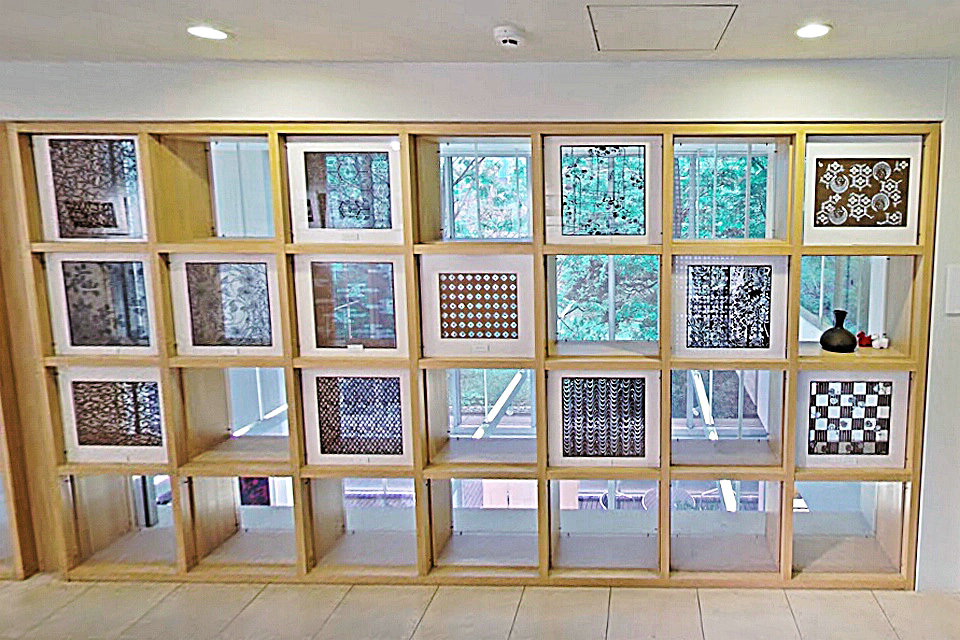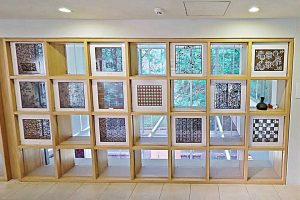A stunning gallery showcasing Japanese culture and arts, designed by renowned architect Taro Ashihara, this innovative and charming gallery can be rented for exhibits, seminars and gatherings of all types.
Ise-Katagami
Ise katagami (伊勢型紙) is the Japanese craft of making paper stencils for dyeing textiles (katagami 型紙). It is designated one of the Important Intangible Cultural Properties of Japan. The art is traditionally centered on the city of Suzuka in Mie Prefecture. This is good for making a certain shape or picture within your project. It is different from Ise washi though both are made in Mie Prefecture.
Multiple layers of thin washi paper are bonded with a glue extracted from persimmon, which makes a strong flexible brown coloured paper. The designs can be extremely intricate, and consequently fragile. Nowadays the stencils are sometimes sold as artwork, attached to hand fans, or used to decorate screens and doors in Japanese rooms. For kimono printing the stencils are stabilized by attaching them to a fine silk net. In past times, human hair was used instead of silk, but silk is less likely to warp and can be finer.
Technique
Three sheets of washi (和紙) or Japanese paper are pasted together with kakishibu (柿渋), tannin-rich persimmon juice. The pattern is excised using a variety of tools known as dōgu-bori (道具彫り). Four principal cutting techniques are used:
Pulling the knife towards the artist, which results in long straight cuts.
Carving patterns, which allows for figurative designs.
Cutting circular holes, often in fan-like designs
Using shaped punches.
The stencils are then used for resist dyeing. Rice paste is passed through the stencil onto silk. When dyed, the color does not adhere to the areas with rice paste. By multiple alignments of the stencil, large areas can be patterned. This technique was developed in France as Silk screen printing. The stencil is not generally used for more than one kimono, though multiple stencils can be cut at the same time.
History
The use of stencils was known by the Nara period, as is evident from objects in the Shōsōin (正倉院). Later paper stencils developed alongside the kimono. It is known as Ise-katagami since towns in Ise Province, now Mie Prefecture, were historic centres of the craft. Production is now primarily localised around the town of Suzuka.
Exhibition:
This treasure trove of beautiful traditional kimono patterns and discover the design and techniques of this exquisite Japanese craft!
This museum introduce to the world Ise-katagami stencils from the Edo to the Shōwa periods. Our rich collection includes numerous Japanese patterns such as edokomon originally used for samurai kimonos, kikagaku (geometrical abstract designs), kachōbūgetsu (traditional themes of natural beauty in Japanese aesthetics) and kojiraigeki (representations of classical literature and history).
Ise-katagami is the Japanese craft of making paper stencils for dyeing textiles. In 1955, it was designated as one of the Important Intangible Cultural Properties of Japan.
With over 5,000 stencils from the Edo to the Shōwa periods, the Edo Ise-Katagami Museum has Japan’s largest Ise-katagami collection.
Kioi Art Gallery, Edo Ise-Katagami Kimono Museum
Ise-katagami is the Japanese craft of making paper stencils for dyeing textiles. It has been designated as one of the Important Intagible Cultural Properties of Japan and there is currently a group of masters who are keeping the tradition alive. With over 5,000 stencils from the Edo to the Showa periods, the Edo Ise-Katagami Museum has Japan’s largest Ise-Katagami collection.
Come to this treasure trove of beautiful traditional kimono patterns and discover the design and techniques of this exquisite Japanese craft!
First developed during the Muromachi period (1337-1573) in Suzuka, a city in the Ise area of Mie prefecture, Ise-katagami is the craft of paper stencils used in kimono dyeing, made on multiple layers of thin washi paper bonded with persimmon juice. Initially controlled and supported by the Kishū Domain, Ise-Katagami became increasingly popular throughout the Edo period. It is nowadays recognized as a fine and applied art.
We opened this museum with the desire to introduce to the world Ise-katagami stencils from the Edo to the Shōwa periods. Our rich collection includes numerous Japanese patterns such as Edokomon originally used for samurai kimonos, kikagaku (geometrical abstract designs), kachōfūgetsu (traditional themes of natural beauty in Japanese aesthetics) and kojiraireki (representations of classical literature and history).
In the closing days of the Edo period, renowned scholar Dr. Siebold brought a large number of Ise-katagami stencils along with ukiyo-e prints to Europe, sparking the birth of the japonisme movement, and spreading the appreciation of this refined craft beyond Japan’s borders and all over the world.


